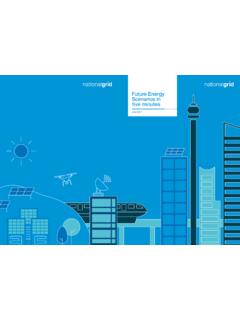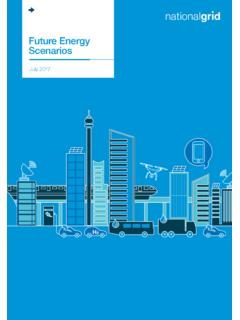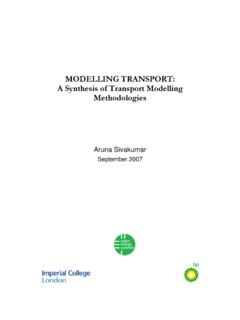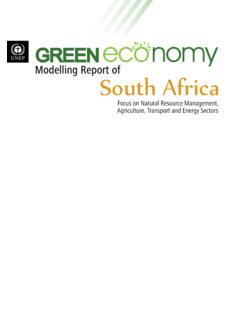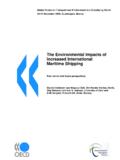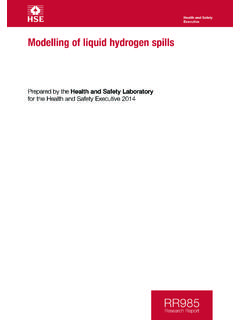Transcription of Modelling Methods - National Grid
1 1 Modelling Methods Our Modelling Methods publication is just one of a suite of documents we produce as part of our Future Energy Scenarios (FES) process. A huge amount of work including Modelling , analysis and interpretation goes into the production of the main document. For ease of use we only highlight significant changes to our Modelling Methods in the main FES document. Alongside this publication we have the Scenario Framework that details all the assumptions and levers that are used as input into our models. Our Charts Workbook contains all the outputs from the numerous models; the detailed tables, graphs and charts. We also publish a summary document FES in 5 and our FAQs. For more information and to view each of these documents visit our website: As our Modelling continues to evolve we will update this document to reflect those changes, ensuring our latest Methods , models and techniques are shared.
2 As with our other FES documents we welcome your feedback, please contact us at: Version | July 17th 2017 2 Contents Energy demand .. 3 Electricity demand .. 3 Gas demand .. 3 Industrial and commercial demand .. 4 Industrial and commercial electricity demand side response (DSR) .. 4 Residential demand .. 5 Residential electricity DSR .. 6 Transport demand electric vehicles (domestic) .. 6 Natural gas and hydrogen vehicles .. 7 Electricity supply .. 8 Electricity supply transmission installed capacities .. 8 Electricity supply distribution installed capacities .. 8 Electricity generation output .. 9 Electricity interconnector capacities .. 10 Electricity interconnector annual and peak flows .. 10 Electricity storage .. 11 Gas supply .. 12 UK continental shelf (UKCS) .. 12 Norwegian supplies .. 12 Shale gas .. 12 Biomethane .. 13 Bio substitute natural gas (BioSNG) .. 13 Liquefied natural gas (LNG) .. 13 Continental interconnector imports.
3 13 Generic imports .. 13 Annual supply 13 Peak gas supply .. 14 Annex - Modelling carbon reduction target .. 15 Annex Electricity security of Supply .. 16 Annex LoLE step by step guide .. 18 Version .. 19 3 Energy demand This section describes the Methods used to model energy demand. Energy demand Modelling is split into five components: 1. Electricity Demand 2. Gas Demand 3. Industrial and Commercial Demand 4. Residential Demand 5. Transport Demand Electricity demand In FES we consider underlying demand. That is end consumer demand, regardless of where (transmission, distribution or on site) the electricity is generated, plus network losses. Demand is weather-corrected to seasonal normal for annual and average cold spell (ACS1) for peak. For clarity it does not include exports, station demand, pumping station demand or other forms of storage demand. When we illustrate residential, industrial and commercial components we have not assigned the distribution or transmission losses.
4 We estimate these losses at the system level to average around eight per cent. Peak demand is the maximum demand on the system in any given financial year. In order to make long-term ACS peak projections from annual demand we apply a recent historical relationship of annual to peak demand. For the residential sector there is a further adjustment using background data from the household electricity survey2. This creates an initial peak demand, to which we add components that history cannot predict, such as EVs, heat pumps and time of use tariffs (TOUTs). Gas demand The annual gas demand is defined as the total Local Distribution Zone (LDZ) consumption, plus the consumption at sites that are directly connected to the National Transmission System (NTS). Total GB annual gas demand includes gas exported to Ireland via the Moffat interconnector and exports to the continent via Interconnector UK.
5 In the Energy Demand section of the FES document, demand only refers to underlying GB demand (excluding interconnector exports) whereas in the Supply section gas supplies are matched to total annual gas demand (including interconnector exports). Losses, and gas used for operating the system, (commonly referred to as Shrinkage) are included at the total system level. All values are weather-corrected where appropriate to ensure we don t allow more extreme weather to skew the results. Peak gas demand is calculated for a 1-in-20 day, as described in our Gas Demand Forecasting Methodology3. Total underlying GB gas demand is put together by Modelling the following individual gas demand components: residential, commercial, industrial, transport and gas for power generation. These components are separated into demand which is connected at distribution and transmission level. 1 {C0855C66-F67D-4D84-9C26-CD4 CAE25D06A}&InitialTabId=Ribbon%2 ERead&VisibilityContext=WSSTabPersistenc e under Electricity capacity Report 2017 2 Cambridge Architectural Research, HES 24-Hour Chooser, 28 April, 2016, E16 3 Chapter 3 National Grid, Gas Demand Forecasting Methodology, November 2016, gas-transmission-operational-data/suppor ting-information/ 4 For the Two Degrees scenario we also model the gas demand required for the conversion to hydrogen.
6 Exports to Ireland and continental Europe as well as NTS and LDZ shrinkage are added to underlying GB demand for gas supply matching purposes. The scenario forecasts for Irish exports are based on Gas Network Ireland s Network Development Plan 20164 covering the next 10 year period. To cover the period from then until 2050, regression analysis is undertaken. Gas demand for power station generation is derived from the pan-European Bid3 generation dispatch tool which produces an hourly dispatch for the GB electricity system. Industrial and commercial demand Industrial and commercial demand includes the demand of offices, shops, hotels, agriculture, ports, airports, manufacturing, power generation and grid scale storage. Four economic scenarios comprised of 24 sub-sectors, and three retail energy price cases from Oxford Economics were used to create energy demand for industrial and commercial sectors. The model examines 24 sub-sectors and their individual energy demands, giving a detailed view of GB demand, and uses an error-correcting model to produce projections for each sub-sector individually.
7 The model then has two further modules to investigate the economics of increasing energy efficiency heat recovery, new technologies such as onsite generation combined heat and power (CHP), and different heating solutions air-sourced heat pumps. These modules consider the economics of installing particular technologies from the capital costs, ongoing maintenance costs, fuel costs and incentives. These are used along with macro-financial indicators such as gearing ratios and internal rate of return (IRR) for each sub-sector to consider if the investment is economical and the likely uptake rates of any particular technology or initiative. This allows us to adjust the relative costs and benefits to see what is required to encourage uptake of alternative heating solutions and understand the impact of prices on onsite generation, which give our scenarios a wider range.
8 Industrial and commercial electricity demand side response (DSR) We have made an assessment of the potential for what DSR could offer to this sector. This assessment was derived from a literature review of DSR potential and used to build our scenario ranges alongside available data on DSR services from the Capacity Market and balancing services provision. We analysed the current development of new technologies and trends and looked at the factors that may impact on engagement by businesses in maximising DSR potential. We started with a hypothesis that the nature of an individual business could limit its DSR participation; power demand profiles of different business sectors have clear signatures. Businesses engagement with DSR is unlikely to reach its full potential in helping to balance the grid without access to appropriate volume and price data. We assume that the deployment of smart Information and Communication Technologies (ICT), and the development of innovative pricing schemes, will influence the levels of DSR.
9 4 5 Adopting ICT will create the potential for the reduction of energy consumption by end users and optimal operation of future smart grids. DSR promoting programs, smart pricing and ICT will not be able to significantly influence DSR individually. The presence of all three approaches will be needed to facilitate engagement in DSR within the industrial and commercial sectors. We anticipated a number of DSR activities as precursors to our Modelling assumptions: Triad avoidance actions Capacity Market auctions Non-BM Balancing services (STOR and Frequency Response) TOUTs and new smart pricing schemes Information and Communication Technologies Residential demand The component parts we use to model residential energy demand are: appliances, lighting, heating technologies, insulation and home energy management systems.
10 Our base housing and population assumptions, developed from analysis from Oxford Economics, are consistent across our Modelling scenarios. We assume that the population of GB reaches million and that the number of homes grows to million by 2050 in all of our scenarios. These compare to a population of million and million homes today. We create residential electricity demand using a bottom-up method and deterministic scenario Modelling . For each component part we use historical data, where available, as our starting point. The main source is the department of Business Energy and Industrial Strategy s (BEIS) Energy Consumption in the UK5. We also gather information on mobile phones, tablets and wi-fi routers from Ofcom s Communications Market From this point, we create projections using a selection of historic assessments; household projection data provided by external consultants; outcomes from reported external projects; regression analysis; deterministic and econometric Methods .

